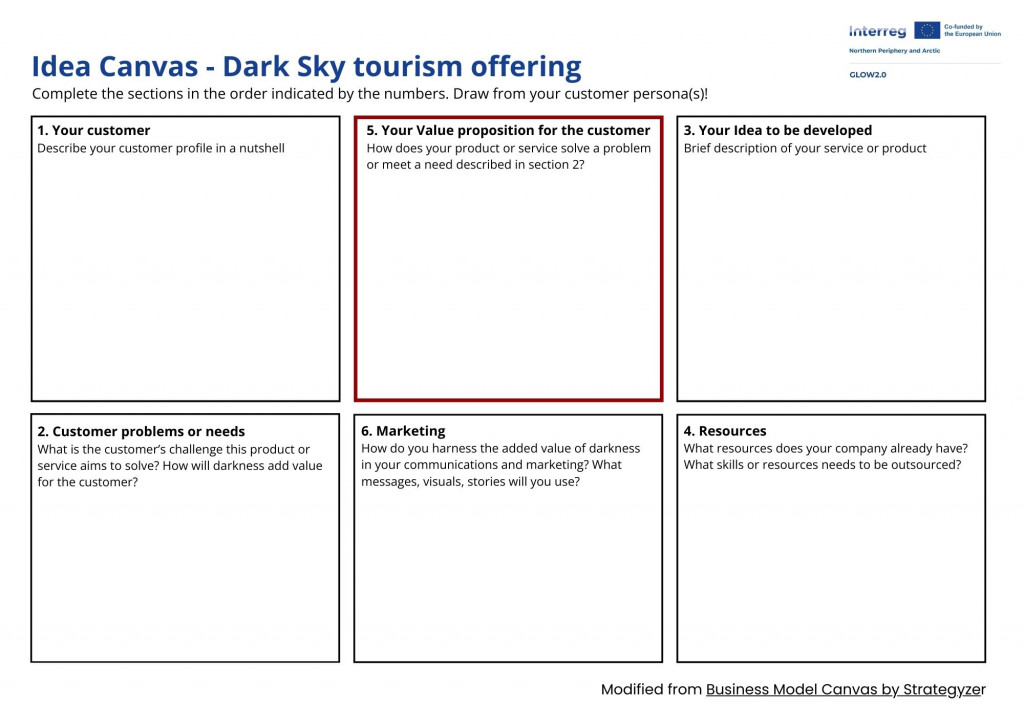Service Design for Dark Sky Tourism II: Define your idea
Section outline
-
Define your idea
Now that you have familiarised yourself with your customer and created some ideas, let's start to define your idea for tourism product. In this module, you will evaluate how a product or service aligns with your customer's needs and develop a value proposition that effectively addresses those needs.
Remind yourself of values and benefits natural darkness can offer for tourism, that we have discussed in study module Embracing the Night II.
Download the Idea Canvas template below. It is modeled after Strategyzer's Business Model Canvas, that you can use for defining and improving your business model. Idea Canvas is aimed for designing a single product or service.

Complete fields 1 through 6 on the template. Begin with describing your customer, as well as their needs and difficulties (1 & 2). Then, describe your idea and the resources needed in the right-hand fields (3 & 4). Lastly, complete the center fields (5 & 6) to connect your idea with your customer's needs.
1. Your Customer
Describe you customer shortly. Utilise the customer persona created in the previous topic. The main thing is to keep you customer in mind, so only few most important descriptions will do.2. Customer problems or needs
What is the task that your customer needs to be solved with a product or service like yours? Usually in the tourism sector these tasks link to customers' need to experience something new, get to know a new country or culture, to relax and get away from everyday life, to improve themselves somehow etc. If you feel stuck with this question, try researching the ready-made customer segments or other studies made on travelers. Most probably you'll find the answers when you consider your own customer base and your own experience in the field of tourism.
Consider also how the element of darkness can add value to your customer, eg. make your offering more suitable for their desires?3. Your idea
Describe your idea briefly. At this point you don't need to fully have figured everything out, just the main activities will do.4. Resources
List the resources needed here. Can you create everything by yourself/you staff, or does something need to be outsourced?5. Your Value Proposition for the idea
This is the point where we bring together your customer and your idea. Value proposition communicates effectively to your customer, why your product or service will solve all their needs. Once you have determined your value proposition for this product, you can use it and it's variations in all your marketing messages. At this point, you don't need to create a finalised version of your value proposition. It is enough to recognise the main points your offering will deliver towards your customers' needs for example in simple bullet points.Take a look once more at section 2. What tasks will your offering solve for your customer? If you can't find the answer, you probably need to tweak your offering, or define a new target group for your product. If this is the case, don't worry! You have already saved lots of time recognising the miscalculation so early.
If your value proposition doesn't fit your customer persona, here are some possibilities:
- Take another look to your customer persona and customer segments, and consider another type of traveler that better suits your offering.
- How can you supplement or modify your idea to make it better suitable for this customer?
If your value proposition and customer persona matched, you can continue.
6. Marketing
You have now created the basis of your main message about this product: your value proposition. Describe here shortly some ideas how to utilise the theme of darkness and value proposition in your marketing. What channels will you use, regarding this typical customer? Refer to you customer persona section about channels of communication that they follow. What kind of visuals can you use to back your main message? What kind of stories can you utilise - is your customer more down-to-earth and straight to business -type of traveler, who only needs the most practical information, or are they more interested in the athmosphere, the ambience and experiences that you can offer them, which may best be conveyed in more descriptive language?